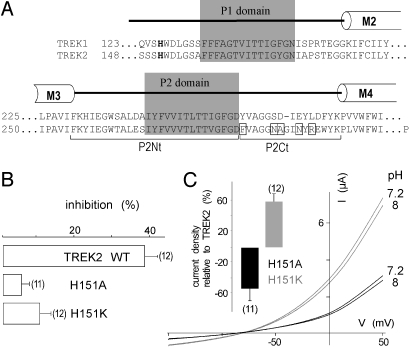Fig. 4.
A conserved histidine residue is the extracellular pH sensor. (A) Sequence alignment of the pore regions from TREK1 and TREK2. The pH-sensing histidine residue is in bold. Residues in TREK2 predicted to interact with the histidine pH sensor are boxed. (B) Percentage of inhibition at pH 8 relative to pH 7.2 at 0 mV for TREK2 and TREK2H151 mutants. (C) Effect of pH on representative TREK2H151A and TREK2H151K currents in Xenopus oocyte in ND96 solution at pH 7.2 and 8. Currents were elicited by voltage-ramps (from −150 to + 50 mV, 1 s in duration). (Inset) TREK2H151A and TREK2H151K current amplitude changes relative to TREK2 current at 0 mV.

